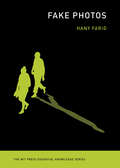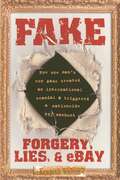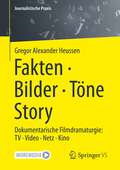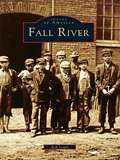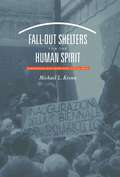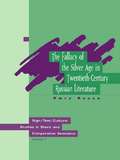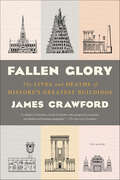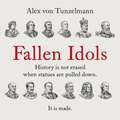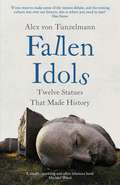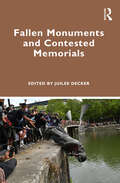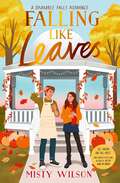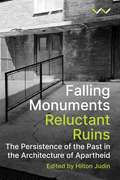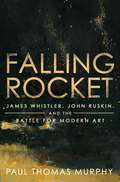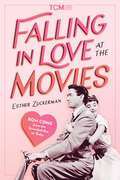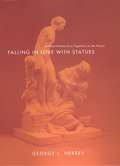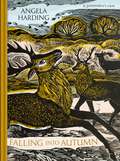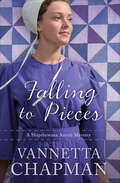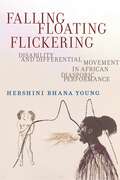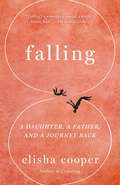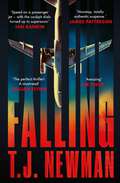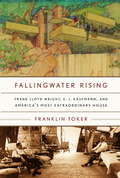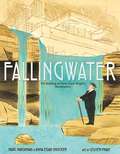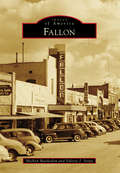- Table View
- List View
Fake Photos (The MIT Press Essential Knowledge Series)
by Hany FaridA concise and accessible guide to techniques for detecting doctored and fake images in photographs and digital media. Stalin, Mao, Hitler, Mussolini, and other dictators routinely doctored photographs so that the images aligned with their messages. They erased people who were there, added people who were not, and manipulated backgrounds. They knew if they changed the visual record, they could change history. Once, altering images required hours in the darkroom; today, it can be done with a keyboard and mouse. Because photographs are so easily faked, fake photos are everywhere—supermarket tabloids, fashion magazines, political ads, and social media. How can we tell if an image is real or false? In this volume in the MIT Press Essential Knowledge series, Hany Farid offers a concise and accessible guide to techniques for detecting doctored and fake images in photographs and digital media. Farid, an expert in photo forensics, has spent two decades developing techniques for authenticating digital images. These techniques model the entire image-creation process in order to find the digital disruption introduced by manipulation of the image. Each section of the book describes a different technique for analyzing an image, beginning with those requiring minimal technical expertise and advancing to those at intermediate and higher levels. There are techniques for, among other things, reverse image searches, metadata analysis, finding image imperfections introduced by JPEG compression, image cloning, tracing pixel patterns, and detecting images that are computer generated. In each section, Farid describes the techniques, explains when they should be applied, and offers examples of image analysis.
Fake: Forgery, Lies, & Ebay
by Kenneth WaltonIt was the golden age of eBay. Optimistic bidders went online to the world's largest flea market in droves, ready to spend cash on everything from garden gnomes to Mercedes convertibles. Among them were art collectors willing to spend big money on unseen paintings, hoping to buy valuable pieces of art at below-market prices. EBay also attracted the occasional con artist unable to resist the temptation of abusing a system that prided itself on being "based on trust. " Kenneth Walton -- once a lawyer bound by the ethics of his profession to uphold the law -- was seduced by just such a con artist and, eventually, became one himself. Ripped from the headlines of the New York Times, the first newspaper to break the story, Fake describes Walton's innocent beginnings as an online art-trading hobbyist and details the downward spiral of greed that ultimately led to his federal felony conviction. What started out as a satisfying exercise in reselling thrift store paintings for a profit in order to pay back student loans and mounting credit card debt soon became a fierce addiction to the subtle deception of luring unsuspecting bidders into overpaying for paintings of questionable origins. In a landscape peopled with colorful eccentrics hoping to score museum-quality paintings at bargain prices, Walton entered into a partnership with Ken Fetterman, an unslick (yet somehow very effective) con man. Over the course of eighteen months they managed to take in hundreds of thousands of dollars by selling forged paintings and bidding on their own auctions to drive up the prices. When their deception was discovered and made international headlines, Walton found himself stalked by reporters and federal agents while Fetterman went on the lam, sparking a nationwide FBI manhunt. His elaborate game of cat and mouse lasted nearly three years, until the feds caught up with him after a routine traffic violation and brought him to justice. In this sensational story of the seductive power of greed, Kenneth Walton breaks his silence for the first time and, in his own words, details the international scandal that forever changed the way eBay does business.
Fakten · Bilder · Töne · Story: Dokumentarische Filmdramaturgie: TV · Video · Netz · Kino (Journalistische Praxis)
by Gregor Alexander HeussenDokumentarische Filme aller Genres in TV, Kino und Netz entfalten ihre informative Kraft erst dann, wenn sie dramaturgisch als Erzählungen strukturiert sind, nicht als Aufzählungen. Sie müssen die Emotionen des Publikums wecken, damit die filmische Information verstanden werden kann. Wirksame dokumentarische Filmgestaltung ist begründet in der Art, wie Menschen hinschauen und hinhören. Ihre Wahrnehmungen werden zu Vorstellungen; diese prägen die Information. Dadurch verändern sich viele überkommene Regeln für Dokumentarische Filme. Neue Ideen werden möglich. Werkzeuge dafür sind der Erzählsatz, die Roten Fäden, die Drama-Elementarmuster, das konzentrierte Zusammenspiel der sechs filmischen Erzähler, Emotionsziel und Argumentziel und die für Erzählungen charakteristische Polaritätslogik. Anders als fiktionale Filme müssen Dokumentarische Filme durch ihre erzählerische Struktur und filmische Gestaltung einen nachprüfbaren Bezug zur Lebensrealität des Publikums schaffen. Spielfilme hingegen können in ihrem jeweils definierten Erzählkosmos plausibel und authentisch sein. Im Dokumentarischen lassen sich auch Werkzeuge und Muster der Fiktionalen Dramaturgie nutzen, aber mit anderer Absicht und Wirkung: sie müssen die Lebensrealität treffen. Das Buch von Gregor Alexander Heussen zeigt Dokumentarische Dramaturgie praktisch; und begründet sie mit Erkenntnissen der Kognitionswissenschaft. Redakteure* und Film-Auftraggeber* finden Werkzeuge und Denkwege für Planung, und Filmabnahme. Autoren* erfahren die Kraft der dramaturgischen Recherche und entdecken neue Gestaltungsmöglichkeiten bei Dreh und Montage. Das Buch ist ein Muss für alle, die sich für dokumentarischen Film in TV, Kino, Netz und Unternehmen interessieren. Mit dem Buch sind 29 runterladbare, sofort nutzbare Drama-Werkzeuge verlinkt.
Fall River (Images of America)
by Rob LewisThe city known today as Fall River, Massachusetts, considered until 1803 to be a part of Freetown and until 1862 to be partially contained within the boundaries of Rhode Island, came into its own as a great industrial city in the latter half of the nineteenth century. The massive power of the Quequechan River fueled several mills, and Fall River granite provided the basis for a developing stone-cutting business. Over the years, the city's numerous villages have been home to many hard-working and loyal residents. These residents historically have much to be proud of: in many ways Fall River led the region in the development of technology and public education. By the 1880s, the city was equipped with telephones, streetcars, and electrical service, and the B.M.C. Durfee High School-opened in 1886-was considered the finest in the nation. Through the 200-plus photographs and informative captions in this marvelous new visual history, local author Rob Lewis seeks to remind residents of Fall River's glorious past; his work also suggests the future potential of this significant American city as we approach the millennium.
Fall-Out Shelters for the Human Spirit
by Michael L. KrennDuring the Cold War, culture became another weapon in America's battle against communism. Part of that effort in cultural diplomacy included a program to arrange the exhibition of hundreds of American paintings overseas. Michael L. Krenn studies the successes, failures, contradictions, and controversies that arose when the U.S. government and the American art world sought to work together to make an international art program a reality between the 1940s and the 1970s. The Department of State, then the United States Information Agency, and eventually the Smithsonian Institution directed this effort, relying heavily on the assistance of major American art organizations, museums, curators, and artists. What the government hoped to accomplish and what the art community had in mind, however, were often at odds. Intense domestic controversies resulted, particularly when the effort involved modern or abstract expressionist art. Ultimately, the exhibition of American art overseas was one of the most controversial Cold War initiatives undertaken by the United States. Krenn's investigation deepens our understanding of the cultural dimensions of America's postwar diplomacy and explores how unexpected elements of the Cold War led to a redefinition of what is, and is not, "American."
Fallacy of Silver Age
by Omry RonenIn this study, Ronen critically examines the term "Silver Age", which over the years has gained such wide currency among historians and connoisseurs of 20th century Russian culture. The author traces the origin and the controversial development of what he condemns as an influential misnomer. Ronen sets out to debunk the myth that attributes invention of the term to Nikolai Berdiaev, and in turn traces this widely used catchword in the critical idiom from an abscure, avante-garde manifesto to the present day. He lays to rest the use of the term which he sees as the most misleading constituent of Russia's contemporary cultural self-awareness and self-assessment.
Fallen Glory: The Lives and Deaths of History's Greatest Buildings
by James Crawford“A narrative that spans seven millennia, five continents and even reaches into cyberspace. . . . I savored each page.” —Henry Petroski, Wall Street JournalIn Fallen Glory, James Crawford uncovers the biographies of some of the world’s most fascinating lost and ruined buildings, from the dawn of civilization to the cyber era. The lives of these iconic structures are packed with drama and intrigue, featuring war and religion, politics and art, love and betrayal, catastrophe and hope. They provide the stage for a startling array of characters, including Gilgamesh, the Cretan Minotaur, Agamemnon, Nefertiti, Genghis Khan, Henry VIII, Catherine the Great, Adolf Hitler, and even Bruce Springsteen.The twenty-one structures Crawford focuses on include The Tower of Babel, The Temple of Jerusalem, The Library of Alexandria, The Bastille, Kowloon Walled City, the Berlin Wall, and the Twin Towers of the World Trade Center. Ranging from the deserts of Iraq, the banks of the Nile and the cloud forests of Peru, to the great cities of Jerusalem, Istanbul, Paris, Rome, London and New York, Fallen Glory is a unique guide to a world of vanished architecture. And, by picking through the fragments of our past, it asks what history’s scattered ruins can tell us about our own future.“Witty and memorable . . . moving as well as myth-busting.” —Times Literary Supplement (UK)“[An] elegant, charged book . . . A well-written prize for students of history, archaeology, and urban planning.” —Kirkus Reviews, starred review“Astute, entertaining, and affecting.” —Booklist“A lovely, wise book.” —Alexander McCall Smith, New Statesman (UK)“A cabinet of curiosities, a book of wonders with unexpected excursions and jubilant and haunting marginalia.” —Spectator (UK)
Fallen Idols: History is not erased when statues are pulled down. It is made.
by Alex von Tunzelmann'Alex von Tunzelmann is one of the most gifted historians writing today. Brilliant and trenchant, witty and wise, Fallen Idols is a book you will adore, devour, and talk about to everyone you know. Hesitate no longer; buy this book.' Suzannah Lipscomb, author, award-winning historian and broadcaster'Like all the best historians von Tunzelmann uses the past to explain what the hell is going on today. She does so with a flair, her signature mix of scholarship and succinctness that is so compelling. If you want to make sense of the statues debate, and the coming culture war over our history, this is where you need to start.' Dan Snow'A timely, sparkling and often hilarious book.' Michael Wood A hugely entertaining and informative narrative on one of the key arguments raging across the globe - how does one honestly celebrate a country's past without knocking down celebrated heroes.In 2020, statues across the world were pulled down in an extraordinary wave of global iconoclasm. From the United States and the United Kingdom to Canada, South Africa, the Caribbean, India, Bangladesh, and New Zealand, Black Lives Matter protests defaced and hauled down statues of slaveholders, Confederates, and imperialists. Edward Colston was hurled into the harbour in Bristol, England. Robert E. Lee was covered in graffiti in Richmond, Virginia. Christopher Columbus was toppled in Minnesota, beheaded in Massachusetts, and thrown into a lake in Virginia. King Leopold II of the Belgians was set on fire in Antwerp and doused in red paint in Ghent. Winston Churchill was daubed with the word 'racist' in London.Statues are one of the most visible - and controversial - forms of historical storytelling. The stories we tell about history are vital to how we, as societies, understand our past and create our future. So whose stories do we tell? Who or what defines us? What if we don't all agree? How is history made, and why?FALLEN IDOLS looks at twelve statues in modern history. It looks at why they were put up; the stories they were supposed to tell; why those stories were challenged; and how they came down.History is not erased when statues are pulled down. If anything, it is made.(P)2021 Headline Publishing Group Limited
Fallen Idols: Twelve Statues That Made History
by Alex Von Tunzelmann'Alex von Tunzelmann is one of the most gifted historians writing today. Brilliant and trenchant, witty and wise, Fallen Idols is a book you will adore, devour, and talk about to everyone you know. Hesitate no longer; buy this book.' Suzannah Lipscomb, author, award-winning historian and broadcaster'Like all the best historians von Tunzelmann uses the past to explain what the hell is going on today. She does so with a flair, her signature mix of scholarship and succinctness that is so compelling. If you want to make sense of the statues debate, and the coming culture war over our history, this is where you need to start.' Dan Snow'A timely, sparkling and often hilarious book.' Michael Wood In 2020, statues across the world were pulled down in an extraordinary wave of global iconoclasm. From the United States and the United Kingdom to Canada, South Africa, the Caribbean, India, Bangladesh, and New Zealand, Black Lives Matter protests defaced and hauled down statues of slaveholders, Confederates, and imperialists. Edward Colston was hurled into the harbour in Bristol, England. Robert E. Lee was covered in graffiti in Richmond, Virginia. Christopher Columbus was toppled in Minnesota, beheaded in Massachusetts, and thrown into a lake in Virginia. King Leopold II of the Belgians was set on fire in Antwerp and doused in red paint in Ghent. Winston Churchill was daubed with the word 'racist' in London.Statues are one of the most visible - and controversial - forms of historical storytelling. The stories we tell about history are vital to how we, as societies, understand our past and create our future. So whose stories do we tell? Who or what defines us? What if we don't all agree? How is history made, and why?FALLEN IDOLS looks at twelve statues in modern history. It looks at why they were put up; the stories they were supposed to tell; why those stories were challenged; and how they came down.History is not erased when statues are pulled down. If anything, it is made.
Fallen Monuments and Contested Memorials
by Juilee DeckerFallen Monuments and Contested Memorials examines how the modification, destruction, or absence of monuments and memorials can be viewed as performative acts that challenge prescribed, embodied narratives in the public realm. Bringing together international, multidisciplinary approaches, the chapters in this volume interrogate the ways in which memorial constructions disclose implicitly and explicitly the proxy battle for public memory and identity, particularly since 2015. Acknowledging the ways in which the past — which is given agency through monuments and memorials — intrudes into daily life, this volume offers perspectives from researchers that answer questions about the roles of monuments and memorials as persistent, yet mutable, works whose meanings are not fixed but are, rather, subject to processes of continual re-interpretation. By using monuments and memorials as lenses through which to view race, memory, and the legacies of war, power, and subjugation, this volume demonstrates how these works, and their visible representations of entitlement, possession, control, and authority, can offer the opportunity to pose and answer questions about whose memory matters and what our symbols say about who we are and what we value. Fallen Monuments and Contested Memorials is essential reading for scholars and students studying cultural heritage, history, art history, and public history. It will be particularly useful to those with an interest in public monuments and memorials; colonial and post-colonial history; memory studies; and nationalism, race, and ethnic studies.
Fallen Superheroes
by Scott Allen Perry Eric Curtis Adam MockUsing superheroes as the allegory, this colorful photo narrative explores the not-so-glamorous and sometimes dark realities of those who strive to live their dreams against all odds. The creators of Mime Very Own Book have reunited to pair trademark imagery with witty snippets to create a hilarious visual smorgasbord of real people and their quest to see themselves as more than they really are. From fast food to the simple pleasures of gardening, this lighthearted spoof reveals the superhero in all.
Falling Like Leaves
by Misty WilsonA small town, a fall festival, and an old flame … Gilmore Girls meets Jenny Han in this seasonal YA romance. &‘All swoon and fall vibes!&’ Lynn Painter, bestselling author of Better Than the Movies Ellis has a plan: apply to Columbia University, study journalism, set herself up for a respectable career. So when her parents announce they&’re separating, and Ellis has to move with her mom from NYC to Bramble Falls, Connecticut, it couldn&’t come at a worse time. Especially as Ellis has no time for distractions, and Bramble Falls has the biggest one of all – local barista Cooper Barnett, former best friend and first kiss, now majorly glowed-up and ignoring Ellis completely. With her aunt roping her into helping plan The Falling Leaves Festival, the biggest event on the Bramble Falls calendar, Ellis can&’t stop bumping into Cooper, and can&’t help but fall in love with the town and the people in it. As her return to Manhattan gets pushed further and further back, Ellis is caught between the future each place represents. Maybe there are some things you can&’t plan for…
Falling Monuments, Reluctant Ruins: The persistence of the past in the architecture of apartheid
by Hilton JudinThis edited collection looks at ruins and vacant buildings as part of South Africa’s oppressive history of colonialism and apartheid and ways in which the past persists into the presentFalling Monuments, Reluctant Ruins: The Persistence of the Past in the Architecture of Apartheid interrogates how, in the era of decolonization, post-apartheid South Africa reckons with its past in order to shape its future. Architects, historians, artists, social anthropologists and urban planners seek answers in this book to complex and unsettling questions around heritage, ruins and remembrance. What do we do with hollow memorials and political architectural remnants? Which should remain, which forgotten, and which dismantled? Are these vacant buildings, cemeteries, statues, and derelict grounds able to serve as inspiration in the fight against enduring racism and social neglect? Should they become exemplary as spaces for restitution and justice? The contributors examine the influence of public memory, planning and activism on such anguished places of oppression, resistance and defiance. Their focus on visible markers in the landscape to interrogate our past will make readers reconsider these spaces, looking at their landscape and history anew. Through a series of 14 empirically grounded chapters and 48 images, the contributors seek to understand how architecture contests or subverts these persistent conditions in order to promote social justice, land reclamation and urban rehabilitation. The decades following the dismantling of apartheid are surveyed in light of contemporary heritage projects, where building ruins and abandoned spaces are challenged and renegotiated across the country to become sites of protest, inspiration and anger. This ground-breaking collection is an important resource for professionals, academics and activists working in South Africa today.
Falling Rocket: James Whistler, John Ruskin, and the Battle for Modern Art
by Paul Thomas MurphyA New York Times Book Review Editors&’ Choice The untold story of the artistic battle between James Abbot MacNeill Whistler and John Ruskin over Whistler&’s controversial, ground-breaking Nocturne in Black and Gold: The Falling Rocket.In November 1878, America&’s greatest painter sued England&’s greatest critic for a bad review. The painter won—but ruined himself in the process. The painter: James Abbot MacNeill Whistler, whose combination of incredible talent, unflagging energy, and relentless self-promotion had by that time brought him to the very edge of artistic preeminence. The critic: John Ruskin, Slade Professor of Art at Oxford University, whose four-decades&’ worth of prolific and highly respected literary output on aesthetics had made him England&’s unchallenged and seemingly unchallengeable arbiter of art. Though Whistler and Ruskin both lived in London and moved in the same artistic world, they had, until June, 1877, managed to remain entirely clear of one another. This was unusual because Whistler had a mercurial temperament, a belligerent personality, and seemed to thrive on opposition: he once challenged a man to a duel because the man accused the painter of sleeping with his wife. (Whistler had, in fact, slept with the man&’s wife.) That November, John Ruskin walked into the Grosvenor Gallery&’s new exhibition of art and gazed with horror upon Whistler&’s Nocturne in Black and Gold: The Falling Rocket. The painting was Whistler&’s interpretation of a fireworks display at a local pleasure garden. But to Ruskin it was nothing more than a chaotic, incomprehensible mess of bright spots upon dark masses: not art but its antithesis—a disturbing and disgusting assault upon everything he had ever written or taught on the subject. He quickly channeled that anger into a seething review. The internationally-reported, widely discussed, and hugely-entertaining trial that followed was a titanic battle between the opposing ideas and ideals of two larger-than-life personalities. For these two protagonists, Whistler v Ruskin was the battle of a lifetime—or more accurately, a battle of their two lifetimes. Paul Thomas Murphy&’s Falling Rocket also recounts James Whistler&’s turbulent but triumphant development from artistic oblivion in the 1880s to artistic deification in the 1890s, and also Ruskin&’s isolated, befogged, silent final years after his public humiliation. The story of Whistler v Ruskin has a dramatic arc of its own, but this riveting new book also vividly evokes an artistic world in energetic motion, culturally and socially, in the last decades of the nineteenth century.
Falling in Love at the Movies: Rom-Coms from the Screwball Era to Today (Turner Classic Movies)
by Esther ZuckermanPrepare to swoon, ugly cry, laugh, and fall in love with this officially licensed exploration of the impact and legacy of one of film's most beloved genres from Turner Classic Movies: the rom-com. Romantic comedies have had an incredible influence on popular culture, shaping everything from how we think of relationships to fashion. Often swept aside in film history, these movies are thought of as pure comfort viewing. Although they certainly provide those fuzzy feelings, they have also had a significant artistic influence and cultural impact. Spanning decades of romantic comedies—from movies of the 1930s such as It Happened One Night and the rom com craze of the 80s and 90s including When Harry Met Sally...all the way to contemporary hits like Crazy Rich Asians, and everything in between—Falling in Love at the Movies will make you fall in love (all over again) with romantic comedies. Esther Zuckerman—accomplished entertainment journalist and member of the New York Film Critic&’s Circle—takes readers on a journey through the rom-com. She examines the aspects that make us so drawn to these types of films, diving deep into the key auteurs—from Preston Sturges to James L. Brooks to Nora Ephron and beyond—who both created and subverted the canon. These directors, actors, and writers shaped the genre, establishing and also busting traditional pillars and tenets of these movies such as the &“Perfect Pair&” or &“The Man in Crisis&” and &“The High Maintenance Woman.&” Featuring full-color images from the films throughout, along the way Zuckerman takes detours, explores iconic lines of dialogue (Who could forget Julia Roberts' &“I&’m also just a girl, standing in front of a boy, asking him to love her&” iconic moment from Notting Hill?) to memorable scenes (the magical moment at the Empire State Building in Sleepless in Seattle) and weaves in interviews of artists and romantic comedy fanatics in the industry. Looking beyond the traditional rom-com, Zuckerman digs into the nooks and crannies, the films that buck the trend of "happily ever after," the ones that think beyond heteronormative narratives, and the indies that kept the rom-com alive outside of the studio system, to offer a more comprehensive story of the rom-com than has ever been seen before—and one that you&’re bound to love. How&’s that for a happy ending?
Falling in Love with Statues: Artificial Humans from Pygmalion to the Present
by George L. HerseyHersey reveals what has been an instrumental practice since antiquity in our efforts to understand, improve, and empower ourselves. Hersey's history of statue love begins in Cyprus, home of the legendary sculptor Pygmalion, who famously grew enamored of his own creation.
Falling into Autumn: part of a beautiful new series from beloved illustrator and print-maker Angela Harding
by Angela Harding'My encounters with nature are very personal. I am inspired by watching jays gathering acorns, owls hooting and the joy of hearing nightingales.''In the shady parts of my garden, ferns grow. In the springtime, the ferns unfurl their tight, rounded, bundled leaves into rich green fingers. By the autumn, these same leaves are starting to go brown at the edges. This seems to be at the same time that the swallows gather to leave. Groups of swallows sit in great flocks on the electric wires that are behind my studio. Together with the ferns, they are markers that the summer has gone; that one season has finished and another is about to begin.'Falling Into Autumn is the third book in a stunning seasonal quartet from beloved printmaker and illustrator Angela Harding. Each title in this pocket-sized series takes readers on a journey through the seasons, reflecting Angela's observations as the nature around her transforms and evolves over the course of a year. Taking in landscapes across the UK including views from her home studio in Rutland, to the Scottish wilderness, via the low-lying marshlands of Suffolk and the windswept hills of Yorkshire, the beautiful illustrations and evocative imagery of the prose make this the perfect book for nature lovers and art lovers everywhere.Featuring over thirty of Angela Harding's favourite prints alongside observations taken from her books A Year Unfolding, Wild Light and Still Waters & Wild Waves, each short, small book in this seasonal collection is a beautiful new way to enjoy Angela's work and celebrate nature and wildlife across the UK at all times of year.Collect all four titles: Spring Unfurled, Summer's Hum, Falling into Autumn, Winter's Song.
Falling into Autumn: part of a beautiful new series from beloved illustrator and print-maker Angela Harding
by Angela Harding'My encounters with nature are very personal. I am inspired by watching jays gathering acorns, owls hooting and the joy of hearing nightingales.''In the shady parts of my garden, ferns grow. In the springtime, the ferns unfurl their tight, rounded, bundled leaves into rich green fingers. By the autumn, these same leaves are starting to go brown at the edges. This seems to be at the same time that the swallows gather to leave. Groups of swallows sit in great flocks on the electric wires that are behind my studio. Together with the ferns, they are markers that the summer has gone; that one season has finished and another is about to begin.'Falling Into Autumn is the third book in a stunning seasonal quartet from beloved printmaker and illustrator Angela Harding. Each title in this pocket-sized series takes readers on a journey through the seasons, reflecting Angela's observations as the nature around her transforms and evolves over the course of a year. Taking in landscapes across the UK including views from her home studio in Rutland, to the Scottish wilderness, via the low-lying marshlands of Suffolk and the windswept hills of Yorkshire, the beautiful illustrations and evocative imagery of the prose make this the perfect book for nature lovers and art lovers everywhere.Featuring over thirty of Angela Harding's favourite prints alongside observations taken from her books A Year Unfolding, Wild Light and Still Waters & Wild Waves, each short, small book in this seasonal collection is a beautiful new way to enjoy Angela's work and celebrate nature and wildlife across the UK at all times of year.Collect all four titles: Spring Unfurled, Summer's Hum, Falling into Autumn, Winter's Song.
Falling to Pieces: A Quilt Shop Murder (The Shipshewana Amish Mysteries #1)
by Vannetta ChapmanIn this mystery by a USA Today bestseller, a Houston woman inherits an Amish country quilt shop in Indiana where she finds herself suspected of murder. When two women—one Amish, one English—each with different motives, join forces to organize a successful on-line quilt auction, neither expects nor wants a friendship. As different as night and day, Deborah and Callie are uneasy partners who simply want to make the best of a temporary situation. But a murder, a surprising prime suspect, a stubborn detective, and the town&’s reaction throw the two women together, and they form an unlikely alliance to solve a mystery and catch a killer.2012 Carol Award Winner for Best Mystery 2012 Southern Magic Best Inspirational Single Title
Falling, Floating, Flickering: Disability and Differential Movement in African Diasporic Performance (Crip #7)
by Hershini Bhana YoungInsists on the importance of embodiment and movement to the creation of Black socialityLinking African diasporic performance, disability studies, and movement studies, Falling, Floating, Flickering approaches disability transnationally by centering Black, African, and diasporic experiences. By eschewing capital’s weighted calculus of which bodies hold value, this book centers alternate morphologies and movement practices that have previously been dismissed as abnormal or unrecognizable. To move beyond binaries of ability, Hershini Bhana Young traverses multiple geohistories and cultural forms stretching from the United States and the Mediterranean to Sierra Leone, Nigeria, and South Africa, as well as independent and experimental film, novels, sculptures, images, dance, performances, and anecdotes. In doing so, she argues for the importance of differential embodiment and movement to the creation and survival of Black sociality, and refutes stereotypic notions of Africa as less progressive than the West in recognizing the rights of disabled people. Ultimately, this book foregrounds the engagement of diasporic Africans, who are still reeling from the violence of colonialism, slavery, poverty, and war, as they gesture toward a liberatory Black sociality by falling, floating, and flickering.
Falling: A Daughter, a Father, and a Journey Back
by Elisha CooperElisha Cooper spends his mornings creating children's books and his afternoons playing with his two daughters. But when he discovers a lump in five-year-old Zoë's midsection as she sits on his lap at a Chicago Cubs game, everything changes. Surgery, sleepless nights, months of treatment, a drumbeat of worry. Even as the family moves to New York and Zoë starts kindergarten, they must navigate a new normal: school and soccer and hot chocolate at the local café, interrupted by anxious visits to the hospital. Elisha and his wife strive to help their daughters maintain a sense of stability and joy in their family life. And he tries to understand this new world--how it changes art and language and laughter--as he holds on to the protective love he feels for his child. With the observant eye of an artist and a remarkable sense of humor, Elisha captures his family's journey through a perilous time and, in the process, shows how we are all transformed by the fear and hope we feel for those we loveFrom the Hardcover edition.
Falling: the most thrilling blockbuster read of the summer
by T. J. NewmanPRE-ORDER THE PAPERBACK EDITION OF DROWNING, THE THRILLING NEW BLOCKBUSTER BY T. J. NEWMAN. OUT JUNE 2024. &‘Amazing . . . Intense suspense, shocks and scares plus chilling insider authenticity make this one very special&’ LEE CHILD 'FALLING is the best kind of thriller (for me as a reader anyway). Characters you care deeply about. Nonstop, totally authentic suspense' JAMES PATTERSON&‘Attention, please: T. J. Newman has written the perfect thriller! GILLIAN FLYNN, #1 bestselling author of Gone GirlYou just boarded a flight to New York.There are one hundred and forty-three other passengers onboard.What you don&’t know is that thirty minutes before the flight your pilot&’s family was kidnapped.For his family to live, everyone on your plane must die.The only way the family will survive is if the pilot follows his orders and crashes the plane. Enjoy the flight. ***Praise for Falling*** &‘Think Speed on a passenger jet - with the cockpit dials turned up to supersonic&’ Ian Rankin &‘Stunning and relentless. This is Jaws at 35,000 feet&’ Don Winslow &‘The best thriller I&’ve read in years. Buckle up&’ Adrian McKinty &‘Attention, please: T. J. Newman has written the perfect thriller! ... Terrific and terrifying, a true page-turner.. A must-read for summer vacation' Gillian Flynn, #1 bestselling author of Gone Girl &‘A jet-propelled thriller that will have you in its grip from first page to last. A truly astonishing debut and an incredible work of pure suspense&’ Steve Cavanagh 'Newman keeps up an extreme pace from the first page—a near-impossible task, considering that the hero is locked in a cockpit, unable to take action himself. This novel is like the films Die Hard and Speed on steroids, creating one of the year&’s best thrillers' Library Journal &‘With characters you&’ll root for and a plot that dips and bounces like a plane hitting turbulence, this thrill ride is impossible to put down&’ Daily Mail &‘A scorching thriller&’ Evening Standard 'Newman&’s [flight attendant] background means Falling brings a freshness and depth to the genre' The Guardian 'A superlative debut . . . This tense, convincing thriller marks the arrival of an assured new talent' Publishers Weekly ' ...full of the kind of authentic detail that comes from personal experience' Literary Review &‘Gripping from the first sentence, this thriller is like no other&’ OK! Magazine 'A remarkable debut' The Sunday Times '... a tense and claustrophobic read, the fast-paced action zipping along at an astonishing rate' Refinery29
Fallingwater Rising: Frank Lloyd Wright, E. J. Kaufmann, and America's Most Extraordinary House
by Franklin TokerFallingwater Rising is a biography not of a person but of the most famous house of the twentieth century. Scholars and the public have long extolled the house that Frank Lloyd Wright perched over a Pennsylvania waterfall in 1937, but the full story has never been told. When he got the commission to design the house, Wright was nearing seventy, his youth and his early fame long gone. It was the Depression, and Wright had no work in sight. Into his orbit stepped Edgar J. Kaufmann, a Pittsburgh department-store mogul--"the smartest retailer in America"--and a philanthropist with the burning ambition to build a world-famous work of architecture. It was an unlikely collaboration: the Jewish merchant who had little concern for modern architecture and the brilliant modernist who was leery of Jews. But the two men collaborated to produce an extraordinary building of lasting architectural significance that brought international fame to them both and confirmed Wright's position as the greatest architect of the twentieth century. Fallingwater Rising is also an enthralling family drama, involving Kaufmann, his beautiful cousin/wife, Liliane, and their son, Edgar Jr., whose own role in the creation of Fallingwater and its ongoing reputation is central to the story. Involving such key figures of the l930s as Frida Kahlo, Albert Einstein, Henry R. Luce, William Randolph Hearst, Ayn Rand, and Franklin Roosevelt, Fallingwater Rising shows us how E. J. Kaufmann's house became not just Wright's masterpiece but a fundamental icon of American life. One of the pleasures of the book is its rich evocation of the upper-crust society of Pittsburgh--Carnegie, Frick, the Mellons--a society that was socially reactionary but luxury-loving and baronial in its tastes, hobbies, and sexual attitudes (Kaufmann had so many mistresses that his store issued them distinctive charge plates they could use without paying). Franklin Toker has been studying Fallingwater for eighteen years. No one but he could have given us this compelling saga of the most famous private house in the world and the dramatic personal story of the fascinating people who made and used it. A major contribution to both architectural and social history.
Fallingwater: The Building of Frank Lloyd Wright's Masterpiece
by Marc Harshman Anna Egan SmuckerIn Bear Run, Pennsylvania, a home unlike any other perches atop a waterfall. The water's tune plays differently in each of its sunlight-dappled rooms; the structure itself blends effortlessly into the rock and forest behind it. This is Fallingwater, a masterpiece equally informed by meticulous research and unbounded imagination, designed by the lauded American architect Frank Lloyd Wright. This book guides young readers through Wright's process designing Fallingwater, from his initial inspirations to the home's breathtaking culmination. It is a exploration of a man, of dreams, and of the creative process; a celebration of potential. Graceful prose and rich, dynamic illustrations breathe life into the story of Frank and Fallingwater, a man and home utterly unlike any other.A Bulletin of the Center for Children's Books 2017 Blue Ribbon BookA National Council for the Social Studies Notable Social Studies Trade Book for Young People
Fallon (Images of America)
by Valerie Serpa Michon MackedonIn the mid- to late 19th century, nonnative populations first settled Fallon, Nevada, and the surrounding areas in Churchill County. Tracts of land were claimed from a desert floor, watered sporadically by the Carson River, which, in "good years," flows abundantly through the region. Fallon can be seen as a palimpsest, having once exclusively been home to Native Americans and then becoming an overland crossroads. In the mid-1890s, Jim Richards established a store at the crossing and Mike Fallon opened a small post office nearby. Now referred to as the "Oasis of Nevada," it is home to thousands. Lahontan Dam, completed in 1915, strengthened early agricultural roots and inspired rural dreams of verdant plenitude. Churchill County presently supports dairies and vineyards as well as farms and ranches. The city of Fallon has developed in significant ways, taking pride in its cultural life, schools, parks, businesses, and city-owned utility enterprises.
